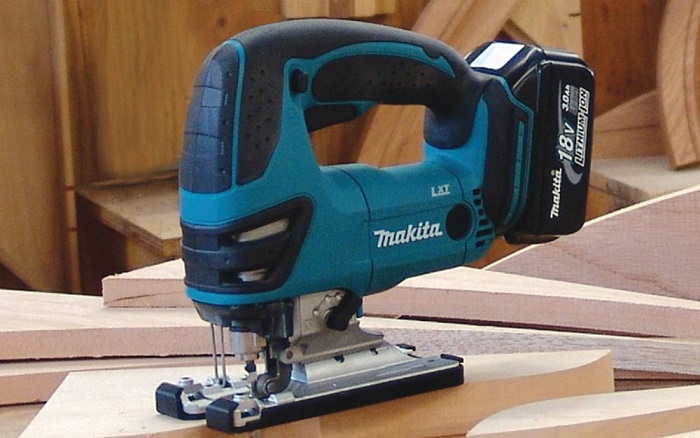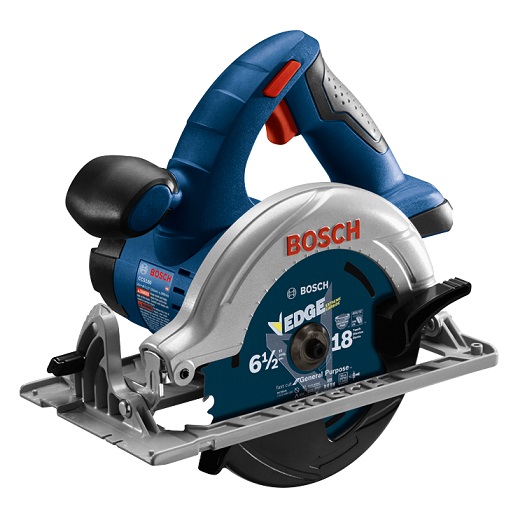Deciding between a jigsaw and a circular saw involves understanding the distinct capabilities each tool offers to your woodworking or construction projects. Jigsaws excel in their ability to make intricate cuts and curves in a variety of materials, including wood, metal, and plastic. This versatility makes the jigsaw an indispensable tool for detailed work and shapes, especially where finesse is required more than brute force.
In contrast, circular saws are the go-to for making quick, straight cuts across larger and thicker materials. Known for their power and speed, circular saws are ideal for tasks like cutting plywood, dimensional lumber, and other sheet goods typically used in construction.
When choosing between the two, consider the typical tasks you undertake in your projects, as each saw provides distinct advantages that can enhance your efficiency and the quality of your work.
What Is A Jigsaw?
A jigsaw is a versatile tool that lets you use it for different projects including arts and crafts and home improvement. You can easily use it for cutting irregular curves which other saws cannot. In a jigsaw, you will find a vertical blade inside a horizontal housing. It works with a reciprocating blade and features shoe guides.
There will be maximum safety while using a jigsaw as it comes with a blade guard. You can use it by holding it and using the trigger for activating it. There is also an adjustable selector for customized operation. Jigsaw lets you use it with different types of materials including wood, plastic, metal, and ceramic tiles. It can come in both corded and cordless designs.
Pros and Cons of Jigsaw
Here are the strengths and drawbacks of Jigsaw you should be aware of.
Pros
- Lightweight design aids in easy portability and maneuverability.
- Ability to make long straight line cuts.
- Perfect for tight spots.
- Allows performing different types of cuts.
- Easy to use.
- Goes with different types of materials.
- Blade replacement does not cost much.
- Comes with a pendulum option.
- Perfect for fewer precision projects.
- Serves great for cutting curves.
Cons
- Difficult while making accurate straight line cuts.
- Blades are prone to breakage.
- Can make a lot of vibration.
- Unsuitable for larger jobs.
What Is The Main Applications Of A Jigsaw?
The main purpose of using a jigsaw is when you require maximum accuracy. It has the ability to make curved cuts. By using a stencil, you can have the best result. Another advantage of using a jigsaw is that you can look for a cordless option and take it anywhere you want. By changing the blades, you can use it with different types of wood.
As jigsaws are suitable for applications with better precision, it makes sure there will be accurate projects. It can even make bevel, straight, and plunge cuts. You can use a jigsaw for –
- Cutting parallel to an edge by adjusting the side fence.
- Creating sweeping curves by attaching a compass.
- Make an aperture inside the board.
- Cutting contemporary fences for better accuracy.
- Make bevel cuts by adjusting the blade’s angle.
What Are the Features Of Jigsaws?
You can use a jigsaw for cutting a wide variety of materials like plastic, wood, countertops, and metal. What it needs is the right blade. One of the main characteristics of a jigsaw is that it has a narrow blade which makes it ideal for cutting curved shapes. It is one of the most important components of a jigsaw that helps to cut the materials. Often, the blade can be in different sizes and forms. While using it, one should consider the measurements carefully.
Another important characteristic is the stroke length. It is the length made by the blade in a single reciprocating movement. If it has a higher stroke length, the distance of cutting the material will be more. Jigsaws also come with pendulum options for moving the blade up and down and back and forth. Finally, a jigsaw includes a motor that is powered by electricity or a battery. Additional characteristics include laser guides and LED lights.
How Does A Jigsaw Operate?
A jigsaw features a relatively narrow blade that moves up and down. You can use it for cutting complex shapes. Additionally, they are also suitable for making straight ad long cuts. It lets you cut different types of materials ranging from wood to metal. As it features a variable speed dial, you can have the speed of your preference.
The design of the jigsaw makes the blade get connected to the motor by the eccentric gears. When you turn on the motor, the blades move up and down quickly. It cuts on the upstroke with the teeth pointing upwards. While using, the base is placed against the workpiece. For cutting metal and plastic, you can opt for slow speed and high speeds are suitable for wood.
What Is A Circular Saw?
If you are looking to make precise and accurate straight-line cuts, a circular saw is the right product. It lets you use it for home repairs and construction sites. The indispensable tool lets you use it for cutting large boards. It is available in a handheld design and you can easily choose from corded or cordless models.
One of the best things about a circular saw is that it can handle different types of materials. It can tackle materials like wood, pipes, metals, and stone. In a circular saw, you will find a tooth circular cutting disc that can rip the materials.
Pros and Cons of Circular Saw –
Here are the strengths and drawbacks of Jigsaw you should be aware of.
Pros
- Comes with a powerful motor for high capacity.
- Ideal for straight-line cuts.
- Bevel adjustment system for bevel cuts.
- Strong and durable blade.
- Ability to cut different types of materials.
- Serves great for dense woods.
- Allows making accurate and precise cuts.
Cons
- Unable to make curved cuts.
- It is heavier than a jigsaw.
- Produces loud noise.
- Needs attention for safety.
- It is expensive.
What Is The Main Purpose Of A Circular Saw?
Circular saws are great for repetitive cutting. For this reason, it is ideal for professional users. The power tool lets you use it for both small as well as large-scale woodworking sites. Additionally, it is also suitable for masonry, sheet work, and metalwork. All you have to do is to get the right blade type.
It can easily adapt to make a variety of cuts like rip cuts, bevel cuts, freehand cuts, crosscuts, and miter cuts. The different types of blades like the pointed tooth blade, rip blade, carbide-tipped blade, fine-tooth blade, and chisel tooth blade let you use it for dealing with different types of materials.
What Are The Features of Circular Saws?
The ideal use of a circular saw is for quickly cutting in a straight line. It features blades ranging from 85 mm to 235 mm in diameter. It can also deal with other materials like plastic, ceramics, masonry, and metal. However, you will have to get masonry cutting blades that do not have any teeth. For plastic cutting, you can get a plastic cutting blade that includes up to 60 teeth. It is the blade that can break through materials at a fast pace. As we have stated that the blades can be in different configurations, you will have to get the one according to your needs.
The blades can have the following characteristics:
Carbide tips offer battery durability.
Cross-cutting blades have small and more teeth.
Rip blades come with large and fewer teeth.
Another important characteristic of a circular saw is that it comes with a bevel adjustment system. This will let you choose the bevel angle for making beveled cuts. As this type of saw moves in a circular motion, the weight is not so important. No matter what the weight is, it can move swiftly and smoothly through the materials. Finally, it is the handle that enables ease of movement.
How Does A Circular Saw Operate?
A circular saw utilizes electrical power to spin the blade. With electric power, it can cut materials according to the type of blade. It features a handle that includes the trigger switch. There is also an arbor nut for holding the blade in place. Best of all, it offers better safety with the guards. You will also find the bevel along with height and depth adjustment systems.
The popular handheld tool will let you use it by clamping the material and adjusting the depth of the blade. Users need to make sure that there is better stability. By squeezing the trigger, the blade will start. It will activate the motor which will make the blade rotate. By releasing the trigger, you can finish the cut.
What Are The Differences Between Jigsaw And Circular Saw?
Utilizing a jigsaw and a circular saw, you will be able to cut different types of materials. This makes both the tools ideal for work sites and home workshops. However, what separates the two is the type of cutting blade. You will have to get the right tool along with the right blade for different types of cutting jobs.
A jigsaw can be great for making curved cuts ts as it comes with a small blade. You can easily use it for the tasks of a circular saw. However, the precision can be less and the time consumed will be more. It has to be noted that a jigsaw blade is delicate and it can break off easily.
Circular saw blades on the other hand are large and can be perfect for large pieces including concrete blocks. It can hold more power and RPMs. You can easily use it for making angled cuts and adjusting the depth according to your needs. It can slice different types of materials as it is a high-powered saw.
Conclusion
By going through the above article, you can now sort the difference between a jigsaw and a circular saw. Both of these are important tools for woodworking. However, they both serve different purposes. You can use a jigsaw for curved cuts. The high-power design of a circular saw makes it ideal for dealing with large wood pieces. With the right type of tool and the right type of blade, there will be seamless work.



